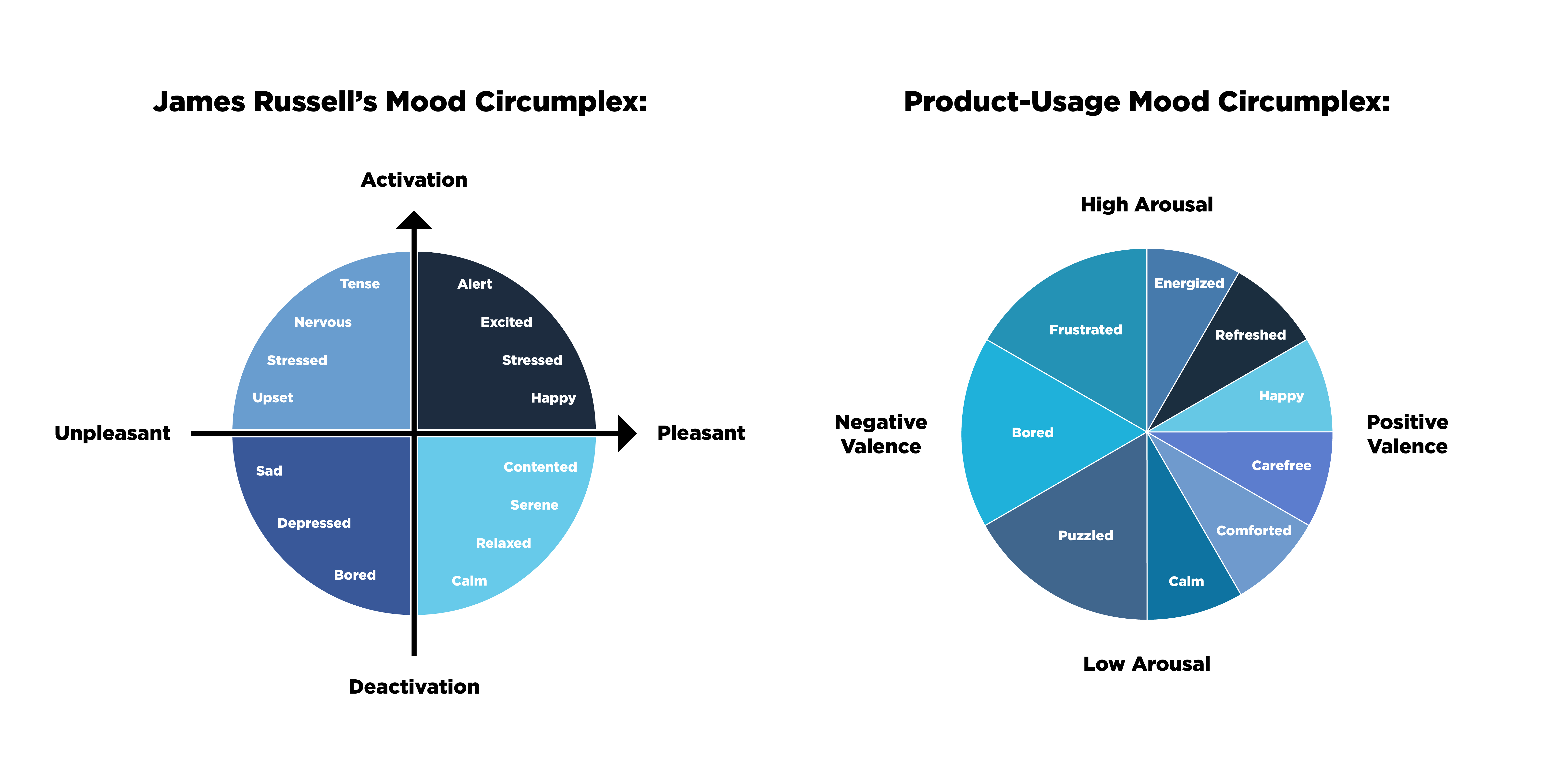Valerie Cansler | VP, Client Services, South
As discussed in part 1, quick-service restaurants can create more robust and flavorful consumer journeys by noting whether consumers “like” or “dislike” each facet of the experience and the emotions each touchpoint evokes. For instance, while “exhilaration” and “comfort” are both positive emotions, they trigger very different consumer responses. With a more granular look into the feelings that drive consumers’ visits, companies can shape their offerings to better align with their target audience’s desired emotional states.
Because emotions are so subjective and difficult to quantify, understanding them as a driving force behind consumer decision-making requires a way to measure emotions accurately and reliably. American Psychologist James Russell created the Mood Circumplex of Affect, which has been proposed as a general model of human emotions. The Mood Circumplex understands emotions as a linear combination of two different dimensions: whether they are pleasant or unpleasant (valence) and activating or inactivating (arousal). Each emotion can be categorized as positive or negative or active or inactive. We may feel alert and excited when we experience positive and active emotions. When our emotions are positive and deactivated, we may feel calm and relaxed. On the other hand, if our emotions are negative and deactivated, we are depressed and bored.
By applying the Mood Circumplex to the emotions experienced throughout the product usage, we created a model that identifies and records consumers’ emotions throughout the product lifespan. Our research revealed 39 unique emotional descriptors that reliably define emotions induced by each finished product and its components. If consumers’ emotional responses were positive and activated, they felt energized and refreshed. If emotions were positive and deactivated, the product made them feel calm and comforted. Negative emotions tend to be less varied on the product-usage Mood Circumplex than the original. Consumers who experienced negative, activated emotions were frustrated by their product experience, while those who reported negative, deactivated emotions were puzzled. Each attribute can provide a nuanced, layered view of consumers’ emotional reactions to products’ fragrance, taste, appearance, texture, and packaging.

The Product-Usage Mood Circumplex applied to the quick-service restaurant industry might include both positive and negative gastronomic descriptors such as “satisfied,” “delighted,” and “indulged,” or “disgusted” and “disappointed.” Taste’s close relationship to emotion and memory positions menu items as a category replete with emotional descriptors to define consumers’ experiences. While other facets of the quick-service restaurant consumer journey, such as packaging, can be tested using an unaltered Product-Usage Mood Circumplex, a menu item that elicits an intensely adverse reaction will likely evoke a stronger emotion than “boredom” or “frustration.”
Curion recently partnered with a company that wanted to understand its consumers’ emotional responses to its products in both the U.S. and Chinese markets. We launched parallel studies in the two regions to provide a global perspective into the relationship between emotion and product liking. The Product-Usage Mood Circumplex proved consistent across both markets and highlighted critical emotional nuances that might have been missed without emotional profiling. The company was able to align its product’s packaging and marketing with the emotions elicited by its offering, creating a more cohesive and strategic brand narrative that set expectations later delivered on by the experience.
Applied to quick-service restaurants, emotional profiling could ensure seasonal products successfully elicit the targeted response from consumers and confirm established and align new menu items with consumers’ emotional drivers. While product-liking traditionally dominates menu testing, it fails to highlight the full spectrum of factors influencing consumer decision-making. Two consumers entering McDonald’s and wanting to indulge in wintertime treats might desire two different emotional states. The first customer craves feelings of comfort and coziness and orders a Peppermint Mocha, while the second customer is in a more celebratory and festive mood and decides on a coveted Holiday Pie. Just as fragrance and texture heavily shape consumers’ emotional experiences in the beauty industry, taste and appearance guide emotional responses in quick service.
Even what quick-serve restaurants choose to name their menu items plays a foundational role in consumers’ emotional experiences. Food Quality and Preference Journal outlined four experiments measuring consumers’ emotional responses to food names and tastes. Leveraging Rated Emotion Testing in all four studies, panelists either read the food name or tasted the food, then rated 39 emotion words on a five-point scale to describe their experience with either the food name or taste. The research unveiled significant variance in participants’ emotional responses between the tasted foods and their food names. The word “chocolate” elicited more intense emotional responses from panelists on 15 of the 39 emotional descriptors than the tastes of either dark or milk chocolate. However, the food name “potato chips” evoked less intense responses in 24 of 39 emotions. The findings of these experiments emphasize the critical role of each facet of the quick-service restaurant experience in creating an emotional experience.
While there are several approaches to emotional testing, Curion’s research suggests Rated Emotion Testing provides more granular insight into consumers’ emotional responses. In a recent test, we leveraged Implicit Association Testing and Rated Emotion Testing to gauge consumers’ emotional responses to fragrances. We used a Check All That Apply (CATA) approach to Rated Emotion Testing, where participants rate each emotion’s relationship to the same on a scale from 1-5. In the Implicit Association Test, consumers were introduced to emotions one by one and answered the prompt “Does this word match your experience?” with yes or no. The comparison results between the two methods were similar; however, the Rated Emotional Testing method displayed a more in-depth overview of variance in data and better-explained discrimination in samples. Detailed insight exploring discrepancies between menu items could help quick-serves fuel more consumer-aligned formulation and menu optimization. The graph below reflects the difference in detail between the two study types. Rated Emotional Testing is labeled as CATA.

Leveraging emotional profiling and testing to add layers of understanding to each aspect of the quick-service experience will not only facilitate better menu offerings and consumer experiences but also allow quick-service restaurants to create cohesive communication, branding strategies, and packaging that deeply resonate with consumers. If emotional profiling reveals that a Limited Time Offering makes consumers feel warm, indulgent, and nostalgic, the quick-service outlet can capitalize on these insights through promotion. For example, McDonald’s re-introduced its crowd-pleasing Halloween-themed packaging design: happy meal containers that double as bucket hats. If consumers find that their emotional tie to a quick-serve restaurant is reflected across the entire product experience, from flavor to interiors, they will feel even more brand connectivity. Marketing claims, packaging, and advertising create expectations that, when delivered, can lead to unparalleled consumer satisfaction and increased brand loyalty.
